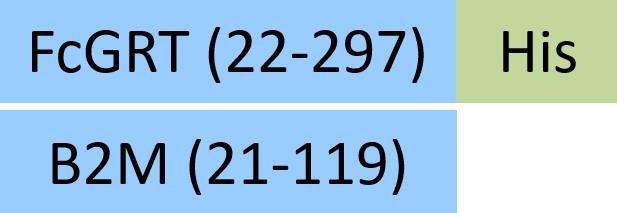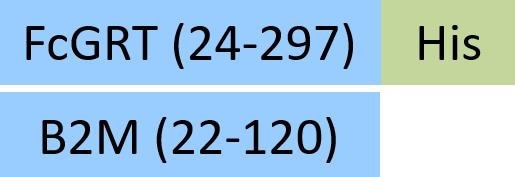IgG was the only class of antibodies that were actively transported from mother to offspring for a long time, and this resulted in short-term passive immunity. The specific IgG transport was realized by FcRn.
In 1972, a receptor that transfers maternal IgG to newborns in the gut of neonatal rats was identified. It was later named as Neonatal Fc receptor (FcRn). FcRn expression at the time of pregnancy and lactation performs a role in transferring IgG across the placental barrier and the intestinal tract.
Various tissue cells can be identified throughout the life cycle. The major function is to retain the IgG level and albumin in the serum and control the distribution in the tissue.
Mechanism of FcRn to prolong the half-life
IgG has a half-life of up to 2 to 4 weeks in the human body. The effect of the half-life is major because of the FcRn-mediated recycling process. This process is achieved by the pH-dependent binding of IgG Fc fragment and serum albumin to FcRn.
Image Credit: ACROBiosystems
In acidic conditions (pH 6.0–6.5), FcRn binds IgG, and dissociation takes place under neutral and weakly alkaline conditions (pH 7.0–7.5). Endothelial cells form endocytosis vesicles by engulfing IgG to form an acidified endosome. IgG binds to FcRn to form an IgG-FcRn complex.
The IgG-FcRn complex is transferred to the cell surface through the recirculated endosome. Under physiological conditions like pH 7.4, the IgG-FcRn complex dissociates and the IgG gets released again into the blood circulation. By this receptor-mediated recycling process, FcRn efficiently safeguards IgG from lysosomal degradation, thus increasing the half-life of IgG.
Yet, IgG does not bind to FcRn to form an IgG-FcRn complex in the acidified body and degrades in the lysosome. Researches have demonstrated that the FcRn-mediated IgG recovery rate is 42% more than the IgG production rate. This indicates that IgG recycling is the major mechanism that retains IgG concentrations in the human body.
Structure of FcRn
FcRn is a heterodimer comprised of two subunits FCGRT and B2M. FCGRT has three extracellular functional regions, including a single transmembrane helix, three soluble domains (α1, α2, and α3) and a cytoplasmic tail (certain researches have demonstrated that the cytoplasmic tail region is made of 44 amino acid residues that may have signals that mediate intracellular pathways).
The molecular weight is 40 to 50 kDa, named the α chain and the molecular weight of B2M is 14 kDa, called the β chain. The two chains are combined with non-covalent bonds. FCGRT assembles with B2M to perform a transport role. Researches have demonstrated that the attaching site of FcRn with IgG and serum albumin is not the same, hence the binding of FcRn to IgG is not obstructed by serum protein.

FcRn has different binding sites with ligand IgG and albumin. Image Credit: ACROBiosystems
FcRn to treat autoimmune diseases
The greater affinity of FcRn has adverse effects on IgG-mediated autoimmune diseases like rheumatoid arthritis, myasthenia gravis or pemphigus vulgaris. Targeting FcRn and inhibiting FcRn circulation can improve IgG catabolism, resulting in whole reduced IgG and pathogenic autoantibody levels, which is anticipated to decrease all autoimmune abnormalities induced by IgG.
Researches have substantiated that FcRn targeting therapy offers quick and more selective IgG reduction than therapeutic plasma exchange therapy for myasthenia gravis. Additionally, the pros of this treatment over numerous clinically used traditional therapies are also shown by the fact that IgA, IgD, IgE and IgM do not depend on FcRn-mediated circulation.
Hence, it does not lead to comprehensive immunosuppression, offering the basis for the safety and precision specificity of FcRn targeting.
Drugs that target FcRn antibodies are presently being evaluated in clinical trials and these include Efgartigimo, Orilanolimab (SYNT001), Nipocalimab (M281) and so on. Nipocalimab (M281) is a potential “best-in-class” anti-FcRn antibody produced by Momenta.
It is capable of treating various autoimmune diseases and was introduced by Johnson & Johnson. Batoclimab is a Hebo Pharmaceutical, from HanAll Biopharma introduced in 2018, and is a complete human antibody targeting the Fc receptor (FcRn) of newborns. They acquired the rights to develop, produce and commercialize it in the Greater China region.
Global Clinical Trials of FcRn Targeting for Autoimmune Diseases. Source: ACROBiosystems

Summary
Drugs targeting FcRn do not use FcRn as a direct target for therapeutic intervention like traditional targets. Rather, it employs the advantages of cellular drug delivery, known as “revolutionary therapy”, that can erase all autoimmune diseases, with greater potential.
Concentrating on the potential of targeting FcRn in autoimmune diseases, principal pharmaceutical companies have come up with promises to treat all autoimmune diseases induced by autoantigens.
ACROBiosystems offers 19 high-quality FcRn protein products to encourage bispecific antibody, monoclonal antibody, ADC drug affinity research and targeted FcRn drug development for the treatment of autoimmune diseases.
Advantages of Fc receptor protein products
- Expressed by HEK293 Cells: post-translational modification and proper protein folding
- High purity: SDS-PAGE verification purity >95%, SEC-MALS verification purity > 90%
- Multiple species: Human, Cynomolgus/Rhesus macaque, Mouse, Rat, Rabbit, Porcine, Feline, Bovine, can be applied wholly to various cross-species experiments
- Low endotoxin: <1.0 EU/µg
- Biotinylated FcRn proteins labeled with Avitag™ provided: The labeling efficacy is high, and the labeling site is specific and clear, which is suitable for ELISA/SPR/BLI detection depending on binding to streptavidin in the mechanism of drug development and optimization process
- High stability: strict quality control to ensure high batch-to-batch consistency
- Affinity verified by SPR and BLI: Activity guaranteed, and protocols offered free of charge
Product list
Source: ACROBiosystems
| Molecule |
Cat.No. |
Host |
Product description |
Structure |
| FcRn (FCGRT & B2M) |
FCM-H5286 |
HEK293 |
Human FcRn / FCGRT&B2M Heterodimer Protein, His Tag&Strep II Tag (SPR & BLI & MALS verified)Hot |
 |
| FCM-H8286 |
HEK293 |
Biotinylated Human FcRn / FCGRT&B2M Heterodimer Protein, His Tag&Strep II Tag, ultra sensitivity (primary amine labeling) (SPR verified) |
 |
| FCM-H82W4 |
HEK293 |
Biotinylated Human FcRn / FCGRT&B2M Heterodimer Protein, Avitag™, His Tag&Strep II Tag (SPR & BLI & MALS verified)Hot |
 |
| FCM-H82W7 |
HEK293 |
Biotinylated Human FcRn / FCGRT&B2M Heterodimer Protein, His, Avitag™ (MALS & SPR verified) |
 |
| FCN-H52W7 |
HEK293 |
Human FcRn / FCGRT&B2M Heterodimer Protein, His Tag (SPR & BLI & MALS verified)Hot |
 |
| FCM-M52W2 |
HEK293 |
Mouse FcRn / FCGRT&B2M Heterodimer Protein, His Tag&Twin-Strep Tag (MALS &
BLI verified) |
 |
| FCM-M52W8 |
HEK293 |
Mouse FcRn / FCGRT&B2M Heterodimer Protein, His Tag (MALS & BLI verified) |
 |
| FCM-M82W5 |
HEK293 |
Biotinylated Mouse FcRn / FCGRT&B2M Heterodimer Protein, His, Avitag™ (MALS & BLI verified) |
 |
| FCM-M82W6 |
HEK293 |
Biotinylated Mouse FcRn / FCGRT&B2M Heterodimer Protein, Avitag™, His Tag&Twin-Strep Tag (MALS & BLI-verified) |
 |
| FCM-R5287 |
HEK293 |
Rat FcRn / FCGRT&B2M Heterodimer Protein, His Tag&Strep II Tag (MALS & SPR verified) |
 |
| FCM-R82W7 |
HEK293 |
Biotinylated Rat FcRn / FCGRT&B2M Heterodimer Protein, Avitag™, His Tag&Strep II Tag (MALS & SPR verified) |
 |
| FCM-R52W5 |
HEK293 |
Rabbit FcRn / FCGRT&B2M Heterodimer Protein, His Tag&Tag Free (MALS & SPR verified) |
 |
| FCM-C5284 |
HEK293 |
Cynomolgus / Rhesus macaque FcRn / FCGRT&B2M Heterodimer Protein, His Tag&Strep II Tag (MALS & BLI verified) |
 |
| FCM-C52W9 |
HEK293 |
Cynomolgus / Rhesus macaque FcRn / FCGRT&B2M Heterodimer Protein, His Tag (MALS & BLI verified) |
 |
| FCM-C82W3 |
HEK293 |
Biotinylated Cynomolgus / Rhesus macaque FcRn / FCGRT&B2M Heterodimer Protein, His, Avitag™ (MALS & SPR verified) |
 |
| FCM-C82W5 |
HEK293 |
Biotinylated Cynomolgus / Rhesus macaque FcRn Heterodimer Protein, His, Avitag™&Strep II Tag (SPR & BLI verified) |
 |
| FCM-P5280 |
HEK293 |
Porcine FcRn / FCGRT&B2M Heterodimer Protein, His Tag&Strep II Tag (MALS & SPR verified) |
|
| FCN-F82W3 |
HEK293 |
Biotinylated Feline FcRn / FCGRT&B2M Heterodimer Protein, His, Avitag™ (MALS & SPR verified) |
 |
| FCN-B82W3 |
HEK293 |
Biotinylated Bovine FcRn / FCGRT&B2M Heterodimer Protein, His, Avitag™ (SPR verified) |
 |
About ACROBiosystems
ACROBiosystems is a cornerstone enterprise of the pharmaceutical and biotechnology industries. Their mission is to help overcome challenges with innovative tools and solutions from discovery to the clinic. They supply life science tools designed to be used in discovery research and scalable to the clinical phase and beyond. By consistently adapting to new regulatory challenges and guidelines, ACROBiosystems delivers solutions, whether it comes through recombinant proteins, antibodies, assay kits, GMP-grade reagents, or custom services. ACROBiosystems empower scientists and engineers dedicated towards innovation to simplify and accelerate the development of new, better, and more affordable medicine.
Sponsored Content Policy: News-Medical.net publishes articles and related content that may be derived from sources where we have existing commercial relationships, provided such content adds value to the core editorial ethos of News-Medical.Net which is to educate and inform site visitors interested in medical research, science, medical devices and treatments.